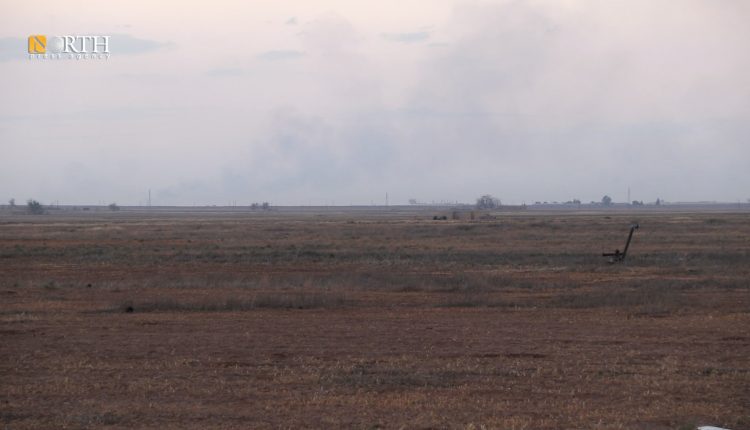
By Dilsoz Youssef
HASAKAH, Syria (North Press) – For six years, farmer and schoolteacher Suleiman al-Darwish has stood at his home in the village of Mahramleh, northeastern Syria, watching his farmland stretch to the horizon, land he has not touched since 2019. Just meters away, it remains off-limits, separated by earthen berms and front lines drawn by advancing Turkish forces and their affiliated armed factions, aka the Syrian National Army (SNA).
When Turkey launched its military offensive on the cities of Sere Kaniye (Ras al-Ain) and Tel Abyad in late 2019, villages and towns north of Hasakah were transformed into conflict zones. The ensuing violence and frequent shelling made it nearly impossible for locals to reach their farmland.
Reality imposed by war
Al-Darwish, 35, teaches at a nearby school and lives close to the front line. Speaking to North Press, he says, “The total area of our village’s land is approximately 4,000 dunums. Our family owns around 500 dunums. Due to the occupation, our land has remained uncultivated for six years now. This has had a significant impact on us.”
In the Hasakah Governrte, most families rely on agriculture as their main source of income. But vast stretches of land now fall within “Forbidden zones” along the front lines, devastating the local economy.
“I have always relied mainly on agriculture,” al-Darwish explains. “These days, we can only look at our land from across the berm. It’s a deeply emotional experience for someone who’s lost their land.”
He adds, “Many people were forced to immigrate because they lost all financial income. Those of us who remain are barely getting by. Maybe someone’s son works in a city or even abroad and can send a little support.”
According to the Agriculture Committee of the Autonomous Administration of North and East Syria (AANES) in Tel Tamr, approximately 20,000 dunams of agricultural land are now located in restricted zones along the front lines near Zirgan (Abu Rasin) and Tel Tamr in northern Hasakah.
Loss and struggle
Driving through the area, signs of destruction are everywhere—shattered homes, shuttered shops, and the nearby presence of a Turkish military base just a few kilometers from Mahramleh.
Residents like Ibrahim Abbas are too afraid to cross the berm and risk being targeted. His family, like many others, has lost access to their 500 dunams of farmland and been forced to seek alternative means of survival.
“Our main livelihood was agriculture. We have about 500 dunums but due to the circumstances, it’s now behind the berm,” Abbas says.
“Our entire family relied on that land. Because of its loss, all my brothers immigrated, some to the Netherlands, others to Turkey. Our situation is tragic and very difficult.”
Now in his twenties, Abbas remembers better times. “An entire family used to live off that land. We had vehicles, full equipment, and a tractor. We were fully self-sufficient from the farmland’s income.”
Destruction and economic collapse
In central Zirgan, the western neighborhood lies almost entirely abandoned after intense shelling left most homes in ruins. Only light foot traffic remains in what was once a lively town.
Hassan Abdullah, who lost his home to shelling in early 2024 and now lives in the eastern neighborhoods, recalls, “The town has been split in two. My house was in the western part, right near the berm that now marks the ‘Forbidden zone.’”
Since Turkish forces set up camp on the town’s outskirts, Abdullah has not been able to reach his farmland—just a few kilometers away—and has had to rely on temporary, low-paying work.
“My farm is just 1 km beyond that zone. There’s a well and everything we need on the land, but we had to leave it behind.”
He continues that the economic situation is worse than zero. There’s no longer any way to earn a living.
Despite the hardship and uncertainty, Abdullah holds out hope for a return—his own and that of the many forcibly displaced families from Zirgan.
